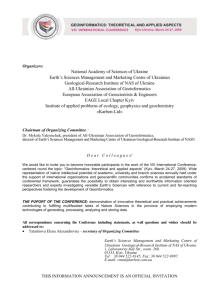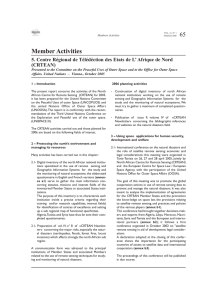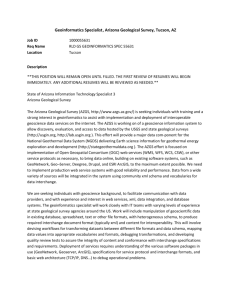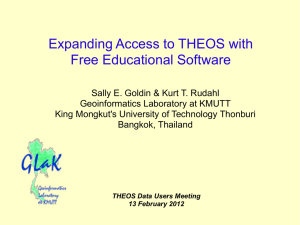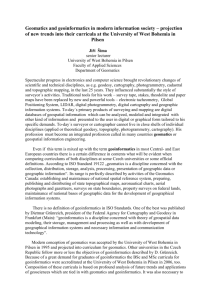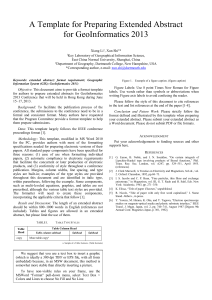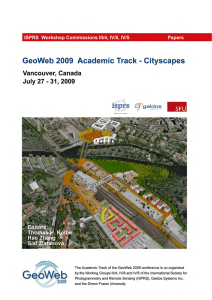QUANTIFYING THE OBVIOUS: ENCOURAGING OUTCOME-ORIENTED RESEARCH IN LESSER DEVELOPED COUNTRIES
advertisement
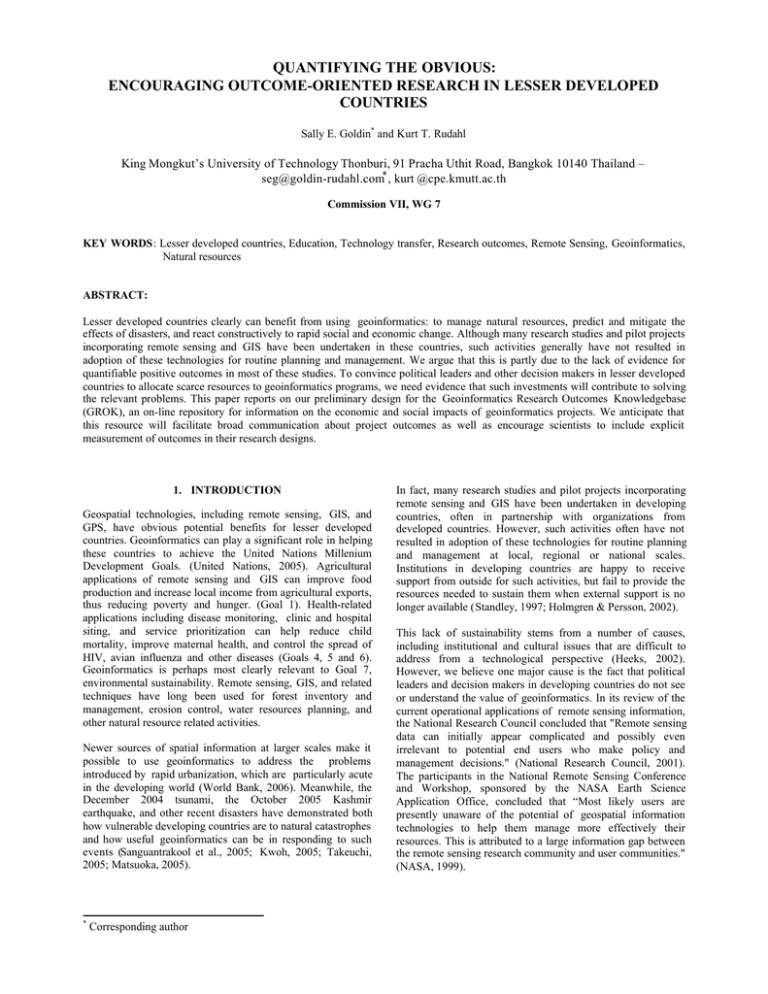
QUANTIFYING THE OBVIOUS: ENCOURAGING OUTCOME-ORIENTED RESEARCH IN LESSER DEVELOPED COUNTRIES Sally E. Goldin* and Kurt T. Rudahl King Mongkut’s University of Technology Thonburi, 91 Pracha Uthit Road, Bangkok 10140 Thailand – seg@goldin-rudahl.com* , kurt @cpe.kmutt.ac.th Commission VII, WG 7 KEY WORDS: Lesser developed countries, Education, Technology transfer, Research outcomes, Remote Sensing, Geoinformatics, Natural resources ABSTRACT: Lesser developed countries clearly can benefit from using geoinformatics: to manage natural resources, predict and mitigate the effects of disasters, and react constructively to rapid social and economic change. Although many research studies and pilot projects incorporating remote sensing and GIS have been undertaken in these countries, such activities generally have not resulted in adoption of these technologies for routine planning and management. We argue that this is partly due to the lack of evidence for quantifiable positive outcomes in most of these studies. To convince political leaders and other decision makers in lesser developed countries to allocate scarce resources to geoinformatics programs, we need evidence that such investments will contribute to solving the relevant problems. This paper reports on our preliminary design for the Geoinformatics Research Outcomes Knowledgebase (GROK), an on-line repository for information on the economic and social impacts of geoinformatics projects. We anticipate that this resource will facilitate broad communication about project outcomes as well as encourage scientists to include explicit measurement of outcomes in their research designs. 1. INTRODUCTION Geospatial technologies, including remote sensing, GIS, and GPS, have obvious potential benefits for lesser developed countries. Geoinformatics can play a significant role in helping these countries to achieve the United Nations Millenium Development Goals. (United Nations, 2005). Agricultural applications of remote sensing and GIS can improve food production and increase local income from agricultural exports, thus reducing poverty and hunger. (Goal 1). Health-related applications including disease monitoring, clinic and hospital siting, and service prioritization can help reduce child mortality, improve maternal health, and control the spread of HIV, avian influenza and other diseases (Goals 4, 5 and 6). Geoinformatics is perhaps most clearly relevant to Goal 7, environmental sustainability. Remote sensing, GIS, and related techniques have long been used for forest inventory and management, erosion control, water resources planning, and other natural resource related activities. Newer sources of spatial information at larger scales make it possible to use geoinformatics to address the problems introduced by rapid urbanization, which are particularly acute in the developing world (World Bank, 2006). Meanwhile, the December 2004 tsunami, the October 2005 Kashmir earthquake, and other recent disasters have demonstrated both how vulnerable developing countries are to natural catastrophes and how useful geoinformatics can be in responding to such events (Sanguantrakool et al., 2005; Kwoh, 2005; Takeuchi, 2005; Matsuoka, 2005). * Corresponding author In fact, many research studies and pilot projects incorporating remote sensing and GIS have been undertaken in developing countries, often in partnership with organizations from developed countries. However, such activities often have not resulted in adoption of these technologies for routine planning and management at local, regional or national scales. Institutions in developing countries are happy to receive support from outside for such activities, but fail to provide the resources needed to sustain them when external support is no longer available (Standley, 1997; Holmgren & Persson, 2002). This lack of sustainability stems from a number of causes, including institutional and cultural issues that are difficult to address from a technological perspective (Heeks, 2002). However, we believe one major cause is the fact that political leaders and decision makers in developing countries do not see or understand the value of geoinformatics. In its review of the current operational applications of remote sensing information, the National Research Council concluded that "Remote sensing data can initially appear complicated and possibly even irrelevant to potential end users who make policy and management decisions." (National Research Council, 2001). The participants in the National Remote Sensing Conference and Workshop, sponsored by the NASA Earth Science Application Office, concluded that “Most likely users are presently unaware of the potential of geospatial information technologies to help them manage more effectively their resources. This is attributed to a large information gap between the remote sensing research community and user communities." (NASA, 1999). In order to convince political leaders and other decision makers in lesser developed countries to allocate scarce financial resources to geoinformatics programs, we need to provide them with evidence that such an investment will actually contribute to solving the relevant problems. However, this kind of evidence is rare and difficult to find, because most geospatial research is not outcome-oriented. Frequently, researchers do not gather the data or perform the analyses necessary to demonstrate that their techniques can provide measurable social or economic benefits beyond the immediate context of their research. Measuring outcomes may not be practical in “pure science” research that aims to establish basic relationships or explore new methodologies. However, based on our observations, even application-oriented research tends to focus on point analyses in particular study areas, with little attention to generalization across either time or space. Furthermore, few research reports attempt to connect the immediate findings with broader social or economic impacts of the work. This paper argues that it is essential to measure and document the positive impacts of geospatial technologies if we want to encourage their adoption in developing countries. First, we examine what it means for a research study or a pilot program to be outcome-oriented, and consider various methods for increasing the number of studies that do quantify their social and economic impacts. Then we describe the preliminary design of a project intended to collect and disseminate outcome information to encourage the use of geoinformatics in developing countries. 2. DEFINING OUTCOME ORIENTATION We define outcome oriented research as research that provides quantifiable evidence for some physical, social or economic benefits associated with the researched techniques. The key phrase in this definition is “quantifiable evidence”. Most researchers and practitioners in geoinformatics consider it obvious that their work has social or economic value. Few design their research to include a quantitative evaluation of that value. Research studies can quantify outcomes in a variety of ways: 1. Longitudinal evaluation. The use, effects, or consistency of research should be revisited some time after the initial results are reported. For example, a flooding hazard map could be evaluated by comparing its predictions with actual flood events in subsequent years. Conclusions from a multi-temporal study of land use change can be evaluated by undertaking a second cycle of change detection at a later date. 2. Generalization. Initial results should be examined for generality using new data or in new regions. For example, a regression model predicting forest degradation developed using data from one study area should be validated by applying it to other areas. 3. Simulation. Since they are based on hypothetical assumptions, simulations do not allow direct measurement of actual outcomes. However, they allow extrapolation into the future, beyond the immediate results of a study, in lieu of a longitudinal evaluation. Simulation can also be powerful device for demonstrating possible outcomes of different scenarios to non-technical people. 4. Evaluation and reporting of statistical significance . Many geoinformatics research studies report differences in results from different data analysis methods or processing algorithms. It is rare to find a study that evaluates the statistical significance of such differences, in order to demonstrate that they are real effects rather than due to random factors. Testing statistical significance in geoinformatics contexts can be a problem, because parametric assumptions frequently do not hold, but there is a wealth of literature on non-parametric techniques that may be appropriate. Significance tests are a weak form of outcome orientation. They bolster the perceived validity of the research results, but do not extend those results beyond the immediate context of a study. Using the definition and operationalizations above, we undertook an informal, post-hoc content analysis to examine whether there was evidence for our claim that outcomeoriented geoinformatics research is not common. We analyzed all complete papers from the proceedings of the most recent Asian Conference on Remote Sensing, which took place in November 2005 in Hanoi, Vietnam. This is the premier geoinformatics conference in Asia, and attracts contributors from all over the region as well as significant participation from Europe, the United States, and Canada. We assigned each paper to one of three categories, as follows: 1. 2. 3. Not application-oriented: pure science or methodological studies, review papers, theory papers, papers describing an implemented or proposed instrument or system design. Application-oriented: no consideration of outcomes Application-oriented: included longitudinal design elements, generalization, simulation, tests of significance, or explicit consideration of the policy and planning implications of the research results. Our results are shown in Table 1. Category Count Percent Not application-oriented 151 52.6 Applications: not outcome oriented 123 42.9 Applications: outcome-oriented 13 4.5 Total 287 100 Table 1. Distribution of ACRS 2005 Papers Roughly half of the papers analyzed involved concrete applications of geospatial technologies to real world problems. Of this number, only ten percent (less than five percent of all the papers) explicitly considered or measured research outcomes. This analysis should be considered as suggestive rather than conclusive, since it was conducted by the authors themselves, with prior knowledge of the hypothesis. Nevertheless, it provides some support for our claim that geoinformatics research frequently fails to provide documentation or measurement of its implications and effects beyond the immediate research context. 3. ENCOURAGING OUTCOME ORIENTATION Our goal is to make outcome information available to decision makers in developing countries, in order to demonstrate the value of geospatial technology in solving real world problems and to encourage its wider adoption. We can identify several strategies for encouraging outcome-oriented research and for making those community. outcomes visible outside the research Design research from the outset to include quantitative evaluation of outcomes. This is the most satisfactory strategy in the long term. However, the typical research environment is rather hostile to this approach. Generally, the academic reward system, which focuses on publication in peer-reviewed journals, penalizes applied research in favor of basic science and “original contributions” (NASA, 1999; National Research Council, 2001). Furthermore, longitudinal evaluation and generalization, the two strongest methods for quantifying outcomes, can require significant additional effort and money, beyond what is needed to produce the initial findings. We need to provide incentives to encourage researchers, especially graduate students, to take a broader view of their work and its significance. Educate students and researchers regarding outcome evaluation and analysis. Many graduate students think that once they have gathered their data, processed it, and produced the maps and tables showing their conclusions, they are done. Geoinformatics curricula need to be broader, to consider project design and management for outcome evaluation, statistical techniques, and the social and economic context of research. Furthermore, peer review guidelines should be revised to consider, encourage, and value outcome orientation in reviewed research. Perform post-hoc analysis of previous research to extract outcome information. In some cases, it may be possible to extract and quantify outcomes from already published research. Generalization and longitudinal analysis can be approximated by considering clusters of related work that apply the same basic techniques and principles in different geographic regions or in the same region at different times. This kind of post-hoc analysis can be done by the original researchers or by technically qualified third parties. However, it is very difficult and resource intensive. Furthermore, the incentive structure of the research community rewards new work, not reinterpretation and reanalysis of previously published work. Disseminate available outcome information as broadly as possible beyond the research community. Assuming that we are successful in increasing the number of outcome-oriented studies, we still face the problem of making this information available and accessible to people who need it. Decision makers cannot be expected to read technical journals or attend geoinformatics conferences. Obviously the World Wide Web provides a global information distribution platform, but designing a repository of outcome information that is accessible to non-technical users is a significant challenge. In the next section we describe our preliminary design for such an online repository, the Geoinformatics Research Outcomes Knowledgebase . 4. GEOINFORMATICS RESEARCH OUTCOMES KNOWLEDGEBASE: PRELIMINARY DESIGN 4.1 Overview Consider the following scenario. The Deputy Minister of the Interior from a relatively impoverished, flood-prone Asian country has received a proposal to establish a flood early warning system based on remote sensing technology. He doesn’t understand most of the technical details, but he needs to know whether the approach is feasible, or whether it’s just some expensive, impractical scheme put together by lowerlevel functionaries who have been dazzled by the claims of data and software vendors. He opens his browser to the Geoinformatics Research Outcomes Knowledgebase, and searches for “flood warning” and “remote sensing”. The search screen is populated with a list of half a dozen projects or studies that successfully used remote sensing as part of a flood prediction or notification application. Selecting one, he reads a summary in non-technical language of the main points and results. He reads comments added by volunteer reviewers and is pleased to see that they are generally positive. Clicking on a link brings him to a follow-up article which provides further evaluation of the same project after a period of two years. Going back to the original search results, he notices that one of the items is a cluster, a group of related research entries that all deal with the same issues. The cluster summary, again written in layman’s terms, makes it clear that remote sensing can be a practical technique for flood prediction, but with certain limitations. With new confidence, the Deputy Minister copies the text of the summary into a report to his superior, recommending that the proposal receive funding. This scenario illustrates our vision for the Geoinformatics Research Outcomes Knowledgebase (GROK). GROK is loosely modeled on the UN Habitat Best Practices database (www.bestpractices.org). BestPractices is “a searchable database of over 2150 proven solutions from more than 140 countries to the common social, environmental and economic problems of an urbanizing world". It is intended to provide ideas, supporting evidence and points of reference for individuals and governments faced with urban problems, by sharing success stories. BestPractices is populated based on submissions from the projects themselves. In order to encourage submissions, UN Habitat gives monetary awards (up to ten awards per cycle, $30,000 per award) to the projects judged as “best” by an independent evaluation committee. However, all submissions, after screening, are included in the searchable database. BestPractices is not geoinformatics-related (a search for “GIS” turned up zero entries), but it serves a similar objective to GROK: to collect and disseminate information about successful approaches and techniques. After examining BestPractices, we decided that the GROK database should also be populated by voluntary submissions. However, we wanted GROK to be self-organizing and selfadministering to the greatest extent possible. Rather than creating an evaluation committee, we decided to rely on voluntary reviews and ratings of submissions to help enforce quality. Since we do not have the financial resources of the United Nations, we cannot offer prizes, but we can use a marketplace approach, like that pioneered on Amazon.com, to provide visibility to the highest rated research entries and the most prolific contributors. We hope that researchers will also be motivated by prestige and by a desire to share their work and see it widely used. 4.2 Users and Goals The GROK site will serve several distinct categories of users with different goals. UML summarizes system use cases via a Use Case Diagram. The diagram shows all the categories of users in the system (called Actors in UML), all the use cases, and their relationships. Figure 2 shows our current Use Case Diagram for GROK. Decision makers in lesser developed countries are the primary audience for the repository. Their primary goal is to find evidence showing positive outcomes of geoinformatics on national development, in order to guide their planning and resource allocation. Researchers are a second important user group. Researchers will access GROK to add and maintain content, group or link content items, and to review content. NGO Staff are also potential users for the system. Like decision makers, their goal is to find evidence of positive outcomes of geoinformatics. However, they will use this information to influence decisions on programs to be funded by their organizations, and support of various country initiatives 4.3 Requirements In our attempt to design GROK’s functionality and interactions, we have identified the following requirements: 1. 2. 3. 4. 5. The system must be accessible to non-researchers. This implies that it must be simple to use, and must avoid technical terminology. The system must provide flexible taxonomies for categorization and searching Although we can provide an initial set of application types, outcome types, and keywords, our list cannot be exhaustive. This implies that users must be able to add categories. Ideally, categories added by one user should be available for selection by other users. The system must make it easy to enter new items. There should be no need for extensive text-editing, and there should be flexible capabilities for linking to content already on-line on other websites. If it is too much work to enter new content, researchers will not do so. The system must provide mechanisms for linking related content items and for creating clusters of items, in order to capture and summarize relationships. The content in the system must be authoritative. We will encourage voluntary reviews with both commentary and ratings to accomplish this. Researchers will receive credit both for posting highly rated content and for their service as reviewers. Poorly rated content may be removed from the system. 4.4 Use Cases for GROK Use cases are a component of the Unified Modeling Language (UML), a standard set of notations and semantics widely used in software engineering and information systems design. A use case describes the typical interactions between users of a system and the system itself in order to accomplish some goal (Fowler, 2004) Use cases provide a way of exploring and documenting functional requirements. A use case is implemented as a structured narrative that lists, step by step, the actions taken by users and the responses from the system. A use case narrative includes both the “main success scenario” and alternative scenarios that will come into effect if some unexpected or abnormal condition occurs. Figure 2. Use Cases for GROK The primary use cases in GROK involve either creating or searching information. Decision makers (a role which includes NGO users as well as users in developing countries) can query the system based on various search criteria to provide a list of candidate research entries to examine (Search Research). By default, research entries will be displayed in order of review rating, with the highest ranked items at the top of the list. Having retrieved a list of candidates, a decision maker can then select specific entries to view further (Show Research Entry). This use case includes the alternative event flows involved in following a link from one entry to another, or viewing an entry that represents a cluster (a group of related research entries). Researchers are involved in creating (Add Research Entry), modifying (Modify Research Entry), grouping (Link Research Entries, Create Cluster) and reviewing research entries (Review Research Entry). (Researchers can also search, of course, but in this case they are acting in the role of “decision makers”). In the use case Review Research Entry, a researcher who was not involved in conducting the research described by the entry will rate it based on specified criteria (e.g. soundness of methodology, strength of results) as well as providing comments. The more positive reviews a research entry receives, the higher its overall rating and visibility in a search. Researchers themselves will receive ratings based on the number of entries they contribute and the number that they review. Creating a cluster will add more to a researcher’s rating than adding a single entry, since it requires more work and thought. Each week the top ranked researchers and research entries will be listed on the GROK home page. We hope that this will encourage researchers to participate both as content contributors and as reviewers. Our intent is that the knowledgebase should be self-organizing. Relationships among entries will be created by technical users based on their specialized knowledge. These users may also expand the taxonomies of application type and outcome type, by attaching new types to the entries they create. Searchers can then use these new types as potential query criteria. The Administrator role has a use case that will allow us to restructure or prune the self-organized taxonomies. For example, if different researchers create entries with application types that are phrased differently, but which appear to be synonyms, the Administrator may decide to combine the synonyms into a single term. The Administrator may also need to remove or hide research entries that consistently receive very low ratings from reviewers. research, for use primarily by reviewers. The source attribute provides a way to link an entry to other on-line content. We will also provide mechanisms for researchers to upload text of their research reports for storage directly on the GROK server. The Cluster class is simply a group of research entries. It has its own title, userSummary and rating attributes, however. The userSummary for a cluster should provide a generalized description, again in non-technical terms, of the combined outcomes of all the grouped entries. 4.5 Research Entry Content We have begun to design the information structures needed for GROK. Eventually this design will translate into a set of application data structures and a database schema, but thus far we have focused on the logical structure of the information to be maintained in the knowledgebase. To document our design decisions in this area, we use another UML construct called a Class Diagram. Class diagrams are associated with objectoriented design methods and languages, but they can also be used to model logical database schemas (Booch et al., 1999). A class diagram shows the primary categories of entities involved in a design, and their relationships including aggregation, association, containment, and so on. For each class, the diagram can specify properties or attributes associated with instances of the class, as well as operations that the class instances can perform. Figure 3 shows a partial class diagram for the GROK system, focusing on the structure of a research entry. This diagram does not include the classes needed to implement reviews and commentary. However, such classes will exist and will be associated in a many-to-on relationship with the ResearchEntry class. 4.6 Open Issues Our work thus far on the Geoinformatics Research Outcomes Knowledgebase has been at the exploratory level. Currently we are evaluating the feasibility and desirability of proceeding with detailed design and implementation. If we continue to work on the project, it will be supported and hosted by the Global Software Institute (GSI) (www.global-soft.org), a nonprofit organization dedicated to applying computer technology to the needs of developing countries. The technical issues involved in implementing GROK are fairly straightforward. The most difficult questions are organizational and cultural. 1. How can we attract a large number of researchers to enter their work into the knowledgebase? Without seeking outside funding, GSI does not have the resources to offer prizes or other financial incentives. 2. How can we inform decision makers about GROK and encourage them to use it? In addition, how can we track GROK usage and evaluate its effectiveness without imposing burdensome registration requirements on users? 3. How do we deal with internationalization? Is it realistic to require all GROK users to work in English? If we decide to support multiple languages, it is not difficult to produce a multi-lingual user interface for GROK, but how do we handle knowledgebase content? Researchers and reviewers will by necessity add information in their own natural languages. How will we make this information accessible to a decision maker who speaks a different language? 4. Is a web-based application like GROK really a reasonable fit to the decision-making culture in developing countries? How can we make the system comfortable and natural for these non-technical and non-Western users? Figure 3. Class Diagram for ResearchEntry and Cluster As illustrated by the diagram, ResearchEntry will store a variety of information about a study or project. The title and authors attributes will be used to identify the entry in search results. The userSummary attribute provides a description of the research and its primary results and outcomes in nontechnical terms. This is one of the most essential attributes in a research entry, since this is the information that decision makers will use to decide if a particular entry is relevant to their problem area. The applicationType and outcomeType attributes are intended to be used as search criteria. Values for these attributes will be drawn from a predefined list (codes) or can be entered as free text by the researcher creating the entry. As discussed earlier, the Administrator will periodically revise the list of available types and assign codes to user-defined options, so that they will be available for use as search criteria. Most of the other attributes should be self-explanatory. The abstract , which is not required, is a technical summary of the The last issue is the most serious. It is critical that we reduce the “social distance” between researchers or application developers and the end users of geoinformatics (National Research Council, 2001). This is difficult even in developed countries, but in lesser developed countries the problem becomes more acute. Heeks (2002) notes that the meaning and implications of technology are very different in lesser developed countries. . The differences can be characterized in terms of “hard” versus “soft” models of reality. Geoinformatics incorporates assumptions and requirements that derive from Western rationalism, but rationalism and cause/effect analysis are not necessarily the dominant paradigm for decision making in the developing world. Decisions in the developing world are often based informal processes that rely more on qualitative than quantitative information, and which incorporate personal and political considerations as well as (or even in lieu of) logical criteria. This is a serious problem not only for our system design, but for our overall argument. Our position regarding the importance of quantifiable outcomes assumes a Western perspective on decision making. It assumes that, given high quality, reliable information on the social and economic benefits that can be derived from geoinformatics, decision makers will choose to use this information in planning and management. If this assumption is not justified, making outcome information available via GROK or any other means will not improve the current situation. Fortunately, decision makers in developing countries are often educated in developed countries, and have at least been exposed to Western styles of thought. Furthermore, one might argue that a rational, cause/effect orientation is required, at least at the level of management, in order for geoinformatics applications to succeed. 5. CONCLUSIONS There are many obstacles to the sustainable adoption of geoinformatics for solving problems in lesser developed countries. The expense of the technology can be prohibitive, particularly when the ongoing costs of staff development, maintenance, and infrastructure are added to the upfront costs of hardware, software and data. A lack of indigenous expertise in geospatial theory and applications can handicap efforts to create operational programs. Cultural, political and institutional barriers also exist. Rather than being seen as a simple enabling mechanism, geospatial technology is viewed in some lesser developed countries as “a complex, value-laden entity: a status symbol for some, a tool of oppression for others” (Heeks, 2002). Despite these barriers, there is substantial interest in developing countries in using geoinformatics for solving practical problems. The ability to point to past successes in applying geoinformatics provides critical ammunition for policy makers working to allocate scarce resources. However, accessible information on positive outcomes is largely lacking. We propose to make such information available via a simple, user-oriented, web-based respository, the Geoinformatics Research Outcomes Knowledgebase. We have presented a design framework for this system, and are ready to begin implementation. However, without changes in geoinformatics education and research incentives, there will be no information available to populate the GROK repository. Researchers need to take a broader view, consider the social context of their work, and design procedures to measure the outcomes of their work. Until this occurs, the corpus of geospatial research will consist largely of isolated studies that do not meet the needs of decision makers. 6. REFERENCES Booch, G., Rumbaugh, J. and Jakobson, I., 1999. The Unified Modeling Language user guide. Addison Wesley Longman: Reading, MA. Fowler, M., 2004. UML Distilled, third edition: a brief guide to the standard object modeling language. Pearson: Boston, MA. Heeks, R., 2002. Failure, success and improvisation of information systems projects in developing countries. Institute for Development Policy and Management, University of Manchester: Manchester, UK. http://www.man.ac.uk/idpm/idpm_dp.htm#devinf_wp (accessed March 10, 2006). Holmgren, P. and Persson, R., 2002. Evolution and prospects of global forest assessments. Unasylva 210, Vol. 53:10-15. http://www.fao.org/docrep/005/y4001e/y4001e02.htm (accessed March 10, 2006). Kwoh, L.K., 2005. Satellite remote sensing imagery for tsunami relief operation and damage assessment. Proceedings of the 26th ACRS, Hanoi, Vietnam, November 8-11, 2005. Asian Association on Remote Sensing: Bangkok, Thailand. Matsuoka, M., 2005. Damage detection to the 2004 Niigata-ken Chuetsu earthquake using RADARSAT images. Proceedings of the 26th ACRS, Hanoi, Vietnam, November 8-11, 2005. Asian Association on Remote Sensing: Bangkok, Thailand. NASA, 1999. Report on the 1999 National Remote Sensing Applications Conference and Workshop. http://www.physics.auburn.edu/~RSAppl99/recommendations. htm (accessed April 8, 2006). National Research Council, 2001. Transforming remote sensing data into information and applications. National Academy Press: Washington, D.C. Sanguantrakool, T., Plongam, S. and Ratansermpong, S., 2005. Tsunami disasters donitoring in Thailand by using geoinformatics technology. Proceedings of the 26th ACRS, Hanoi, Vietnam, November 8-11, 2005. Asian Association on Remote Sensing, Bangkok, Thailand. Standley, T., 1997. GIS implementation in developing countries - a United Nations perspective. Proceedings of the GIS/GPS Conference '97. The Center for GIS - State of Qatar. http://www.gisqatar.org.qa/conf97/links/m3.html (accessed March 10, 2006). Takeuchi, W., 2005. Near-real time active fire mapping over Asia using Aqua/Terra MODIS. Proceedings of the 26th ACRS, Hanoi, Vietnam, November 8-11, 2005. Asian Association on Remote Sensing, Bangkok, Thailand. United Nations, 2005. The Millenium Development Goals Report 2005. Available at http://unstats.un.org/unsd/mi/mi_dev_report.htm (accessed 9 April, 2006). World Bank (2006) "Urbanization and Cities: Facts and Figures". http://worldbank.org/urban/facts.html (accessed 9 April, 2006).
